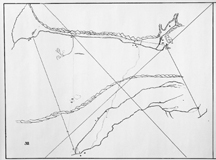|
Blandina Kiersted Bayard’s Purchase of Land from the
Hackensack Indians, 1700.
Deed of Purchase between Blandina Bayard and the
Hackensack Indians, 1700
Courtesy, Collection of The New-York Historical Society
New
York–New Jersey Boundary Papers, vol. 3, pp. 425-427
Click on the images to enlarge.
Click here for transcription.

Map of the Schuyler Patent, by William Bond, 1710
Courtesy, Bergen County Deed Office,
Hackensack, NJ
Carol Greene, The Region Called Ramapough
These documents are early evidence of contacts
between colonial women and Lenape men and women. In 1700 Blandina
Kiersted Bayard (1653-1702), the daughter of Sarah Kiersted, a
translator for the Lenape sachem, Oratam, purchased from the local
Hackensack Indians (the local Lenape group) a sizeable area of land
encompassing what is now Mahwah, Oakland, and Franklin Lakes in Bergen
County. A descendent of settlers in New Amsterdam, Bayard was the widow of
Peter Bayard of New Amsterdam and the mother of five children. Bayard was
a trader with the Lenape and under English law, as a widow, controlled her
own property.
The deed of sale, above, shows that 15 Hackensack men and 4
Hackensack women participated in the sale, though land ownership was not a
concept the Lenape recognized. In return for the land, they
received "divers good causes and several kindnesses,"as well as
"sundry goods and wares," valued at 120 Pounds. Bayard built a
house on the Ramapo River, in what is present-day Mahwah, which served as
a trading post. Though she herself probably did not live full-time on her
land, she engaged her daughter-in-law and a nephew to run the trading
post. Blandina Bayard died in 1702 and her nephew, Lucas Kiersted, took
over her land.
The William Bond Map of the area, drawn in 1710, shows the
proximity of the trading post and Hackensack Indian long houses, and the
Indian trail running from the house to the Paramus area. Such land purchases between early colonists and the local
indigenous peoples prepared the way for the dislocation westward of the
various Lenape groups and for decades of bitter land disputes between
early colonists and the New Jersey Proprietors over rightful title to the
land. For more information about Blandina Bayard see the study by Carol
Greene cited above.
|